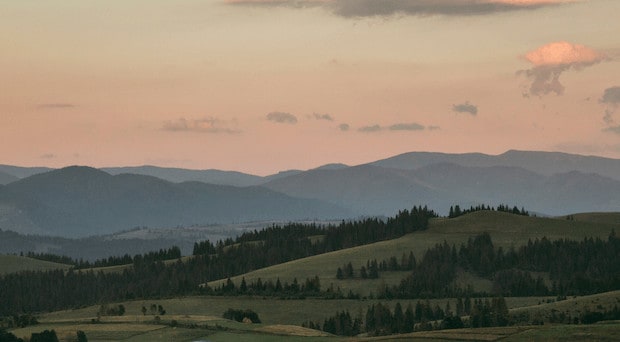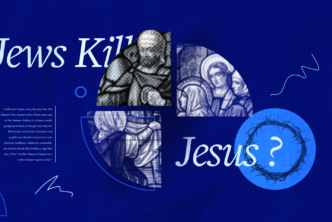By David B. Schreiner
A common word for “mountain” in the Greek New Testament is oros, and Matthew uses it more than any other book. Technically speaking, oros is an imprecise term that can refer to anything from a hill to tall mountain.1 Of the four Gospels, Matthew leads the way with 16 occurrences of oros (Mark has 11, Luke 14, and John five). Clearly, the Gospel writers remember how mountains were an important backdrop for Jesus’ ministry.
A strategic setting
The first passage in Matthew featuring a mountain is the temptation narrative (Matt 4:1–11). Satan leads Jesus to a “very high mountain” and offers him “all the kingdoms of the world and their splendor” (4:8). It’s a temptation of global lordship, if only Jesus would declare allegiance to God’s adversary. Of course, Jesus flatly refuses. Mark’s account of this episode doesn’t mention the setting (Mark 1:12–13), while Luke’s version has only a vague reference to a mountain: “Then the devil led him up and showed him in an instant all the kingdoms of the world” (Luke 4:5). This suggests a tendency in Matthew’s Gospel to emphasize mountains as settings for strategic moments in Jesus’ ministry.
Other passages in Matthew support this idea. In chapter 5, at the start of the Sermon on the Mount, we read that Jesus ascended an unnamed oros to teach. This setting is emphasized again at the end of the sermon, as Jesus encounters great crowds and people craving to be healed when he comes down the oros (Matt 8:1). Similar to the temptation narrative, Luke gives this sermon a different context, further supporting the notion that mountains play an important role in Matthew’s Gospel.2
Matthew 15:29 recounts Jesus passing along the Sea of Galilee and ascending another unnamed oros, where large crowds, including the sick, meet him. He heals the mute, the lame, the blind, and others. The text says the crowd was amazed, which recalls the amazement of Jesus’ audience as they listened to his mountaintop sermon eight chapters earlier (7:28).
Mountains also offer Jesus a secluded place to get away from the crowds. Immediately after feeding the 5,000, Jesus sends away the crowds and even his disciples and goes up to an oros to pray (14:22–23). In the evening, he descends the mountain and walks on the Sea of Galilee. The accounts in Mark and John also make a connection between praying on a mountain and walking on the water (Mark 6:46; John 6:15).
[pullquote]
Mountains were perceived as places where heaven and earth met, where the deities lived and issued their decrees, and where cosmic forces did battle. In Jewish tradition, the idea of a cosmic mountain shaped how people thought about Mount Sinai and the Temple Mount in Jerusalem.[/pullquote]
Jesus again ascends to a “high mountain” in Matthew 17:1, and this time Peter, James, and John accompany him. Here Jesus is transfigured and suddenly joined by Moses and Elijah. Then a voice from a cloud declares him to be God’s beloved Son and commands the three disciples to heed his words (17:5).
Another important mountain in Matthew is the Mount of Olives, which functions as a staging area during the week leading to Jesus’ crucifixion—a place where he regularly returns and educates the disciples on the coming events (21:1; 24:3; 26:30). Matthew’s closing scene takes place on an unnamed mountain in Galilee, where the resurrected Jesus gives his Great Commission to the disciples (28:16).
Cosmic mountains
It’s one thing to observe that mountain settings play an important role in Matthew. But what’s the significance behind them? To answer that question, we have to consider what mountains meant to people in the ancient world.
Mountains were perceived as places where heaven and earth met, where the deities lived and issued their decrees, and where cosmic forces did battle.3
In Jewish tradition, the idea of a cosmic mountain shaped how people thought about Mount Sinai and the Temple Mount in Jerusalem.4 These same views are reflected in Matthew’s Gospel. In fact, Jesus’ accomplishments on certain mountains in Matthew line up with the key features of a cosmic mountain:
- On a very high mountain deep in the Judean wilderness, Jesus overcomes evil and proves himself ready to carry out God’s redemptive plan.
- Later in his ministry, Jesus prepares himself to strike a devastating blow against sin and Satan by spending his final days on the Mount of Olives.
- On the Mount of Transfiguration, heaven and earth collide in a way that recalls Mount Sinai—with clouds, proclamations, and even the presence of Moses.
In Matthew 5–7, when Jesus gives his most famous sermon on a mountainside, he presents a new standard for defining God’s kingdom and God’s people. The setting portrays Jesus as a second Moses and reflects the tradition of divine decrees being issued on cosmic mountains. Even the crowds encounter the very presence of God Almighty on a mountain as Jesus heals the masses.
There is one final nuance associated with Matthew’s use of mountains. Instead of focusing on one particular mountain, Matthew features several mountains as settings for important events. This suggests that a person—not a fixed geographical point—holds the key to understanding how the heavenly realm will break into the earthly realm. The real significance isn’t where, but who.
***
David B. Schreiner teaches Old Testament at Wesley Biblical Seminary in Jackson, Mississippi. He is currently researching 1 and 2 Kings and recently published Pondering the Spade: Discussing Important Convergences between Archaeology and Old Testament Studies (Wipf & Stock, 2019).
This post originally appeared in the January/February 2020 edition of Bible Study Magazine.
Scripture quotations are from the New Revised Standard Version.
- BDAG, 724.
-
In Luke, Jesus gives the Beatitudes “on a level place” (topou pedinou; 6:17).
-
For example, Richard J. Clifford, The Cosmic Mountain in Canaan and the Old Testament, HSM 4 (Cambridge: Harvard University Press, 1972).
- Most notably Jon D. Levenson, Sinai and Zion: An Entry into the Jewish Bible (San Francisco; HarperCollins, 1985).







